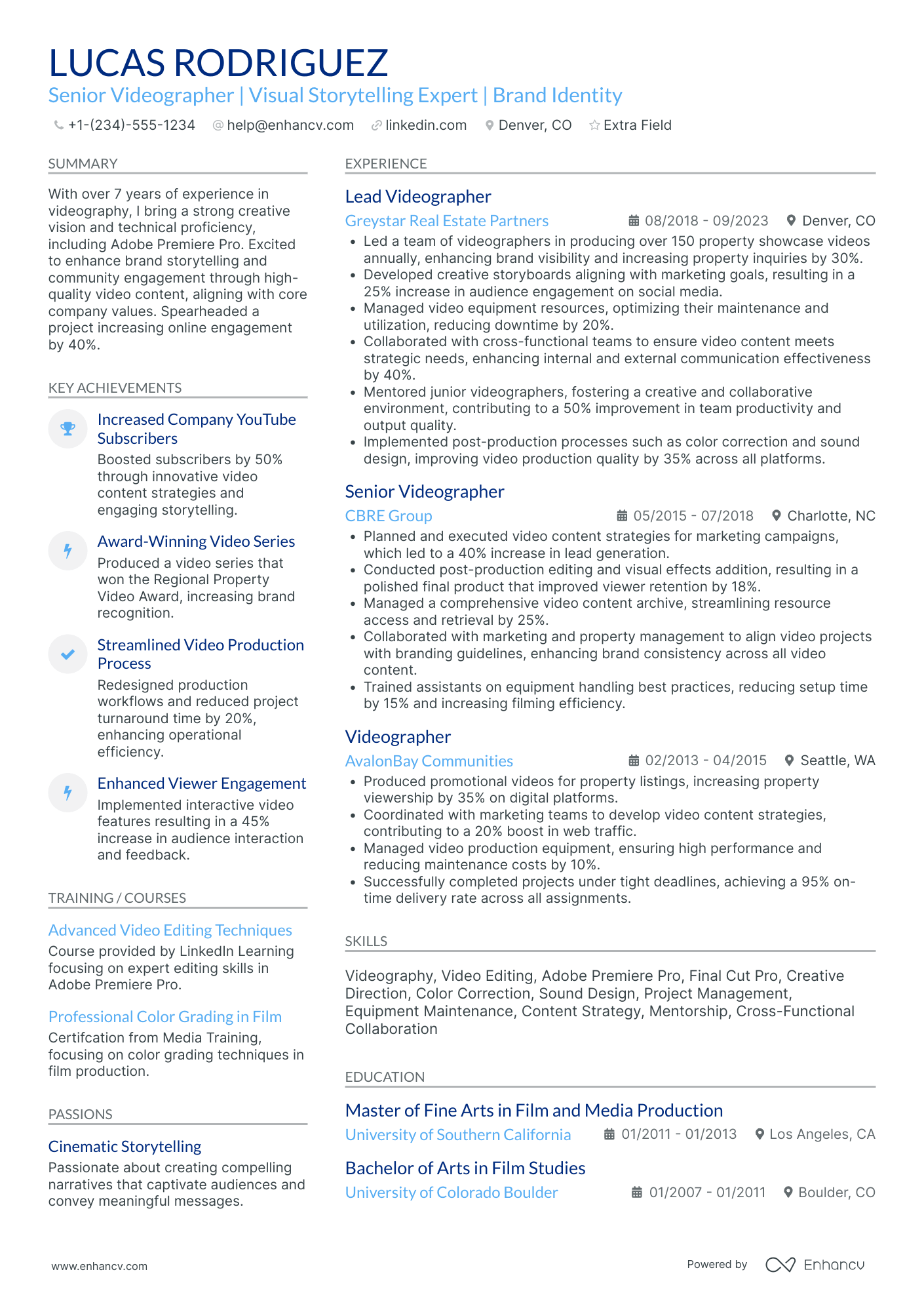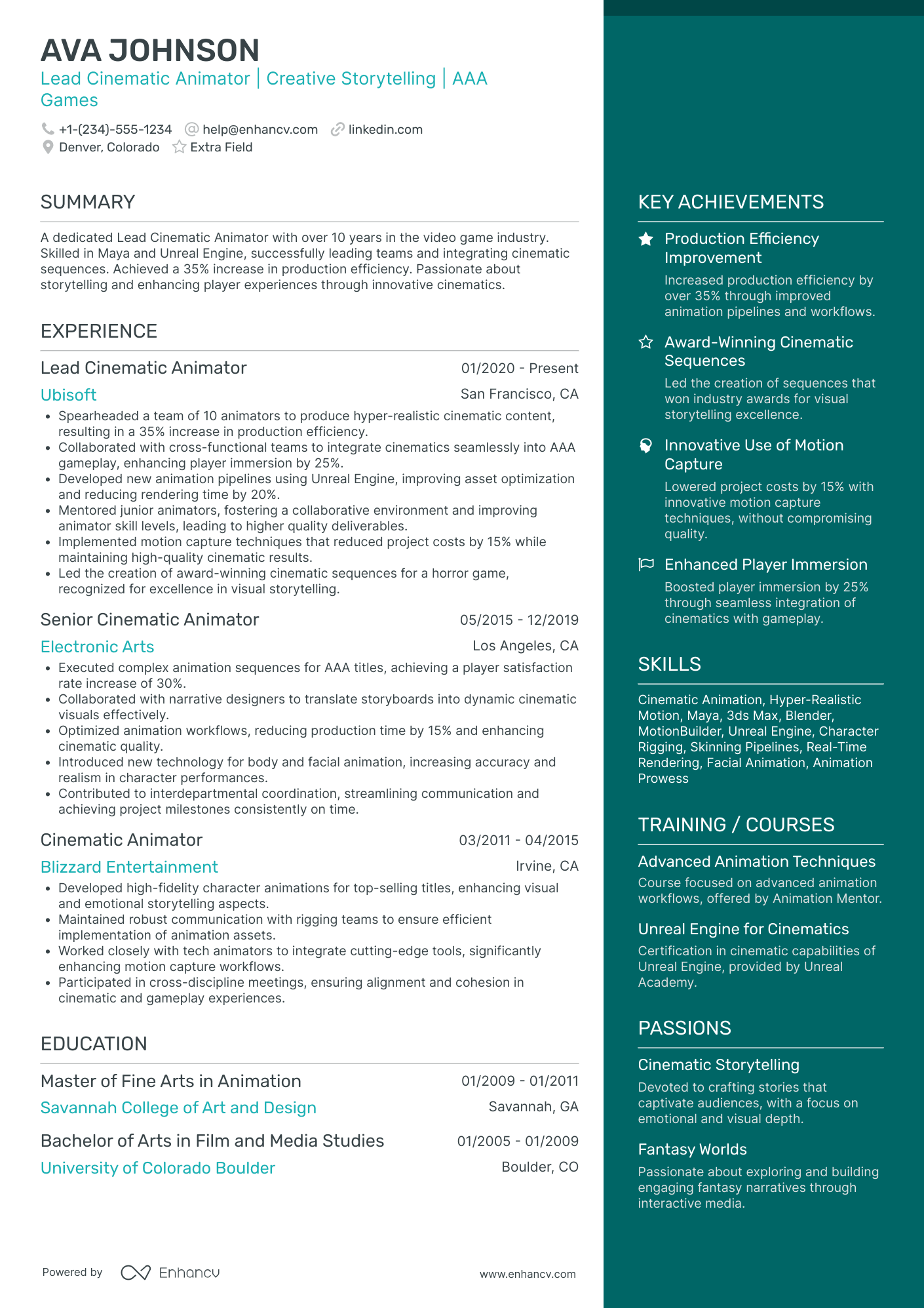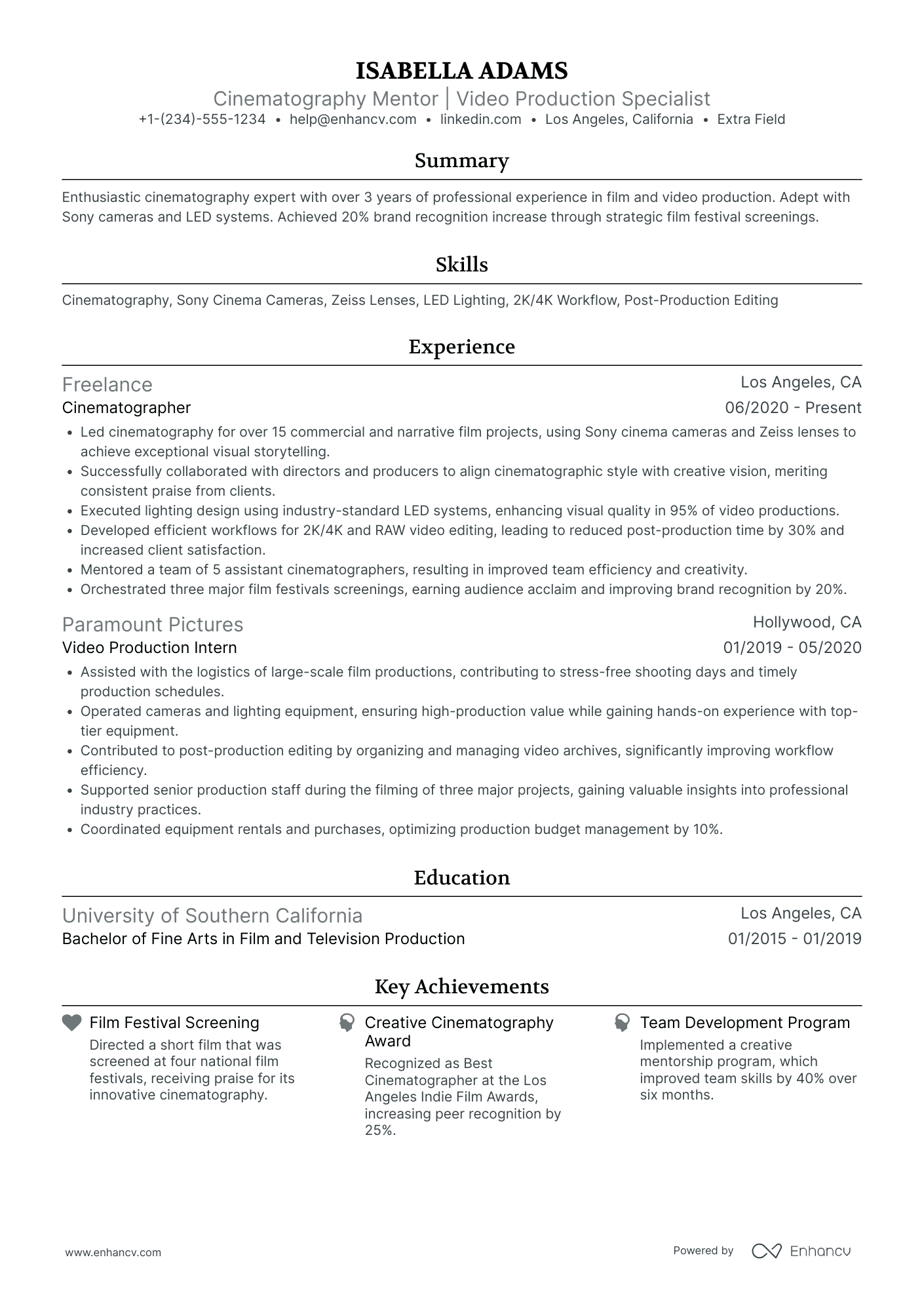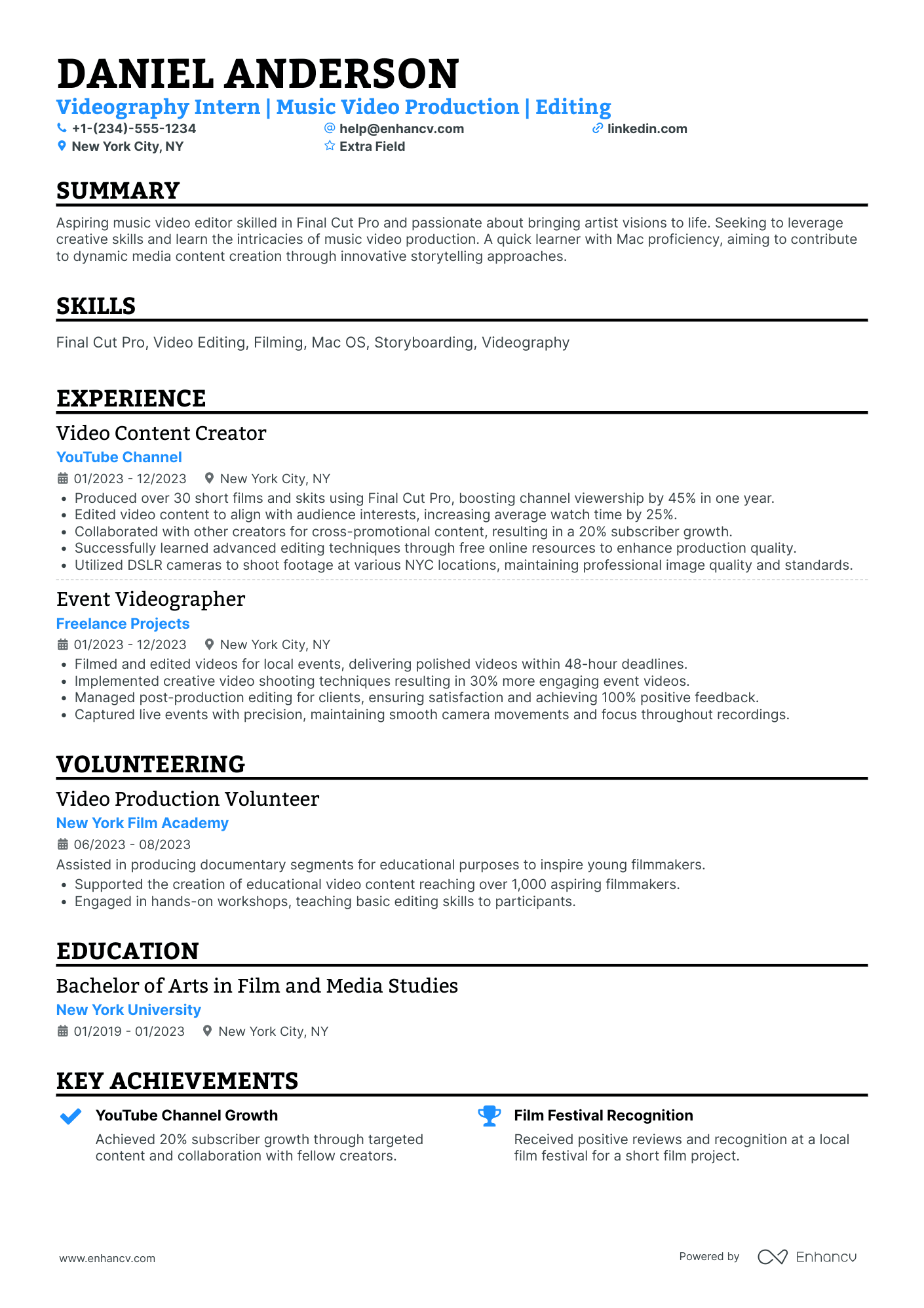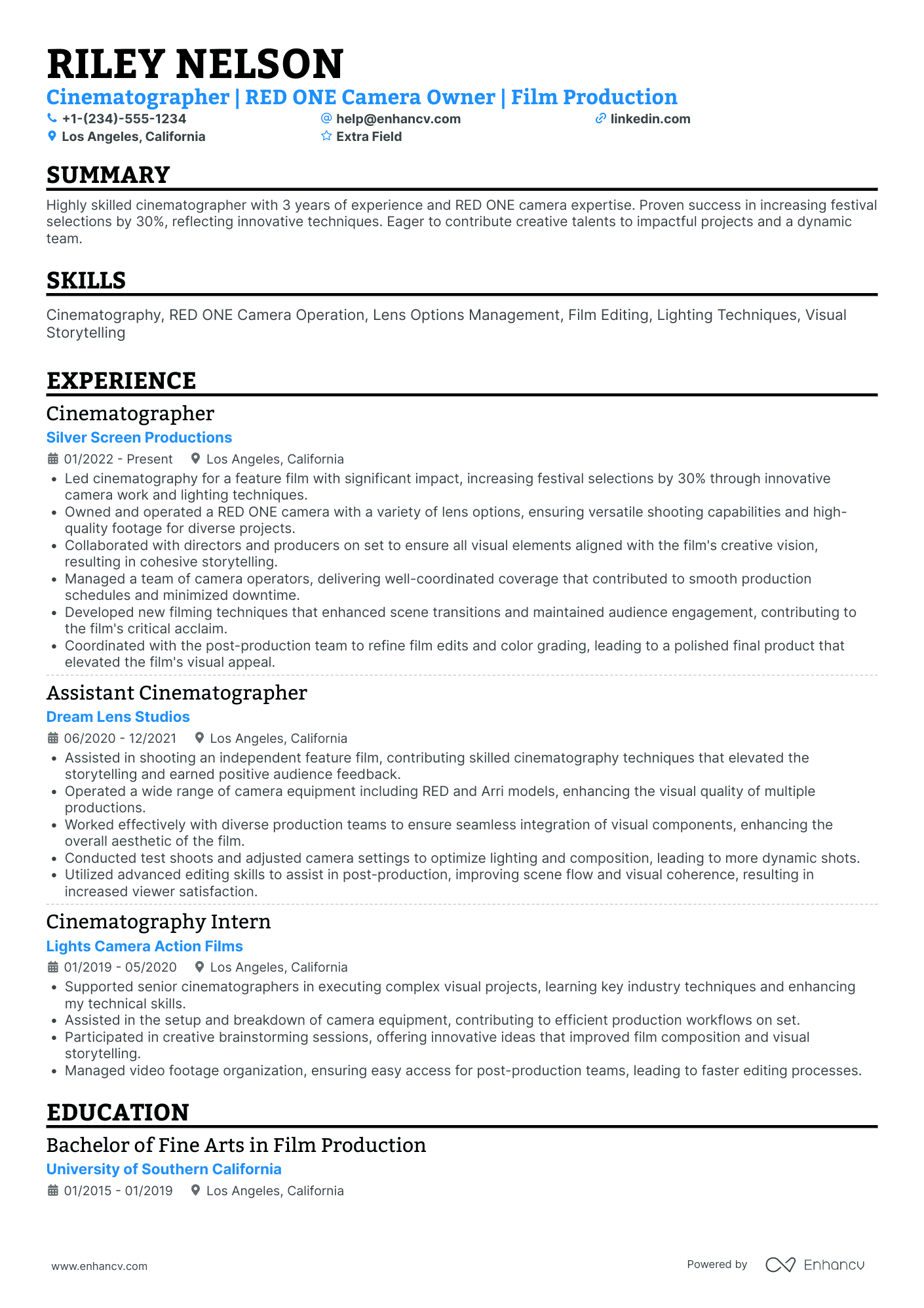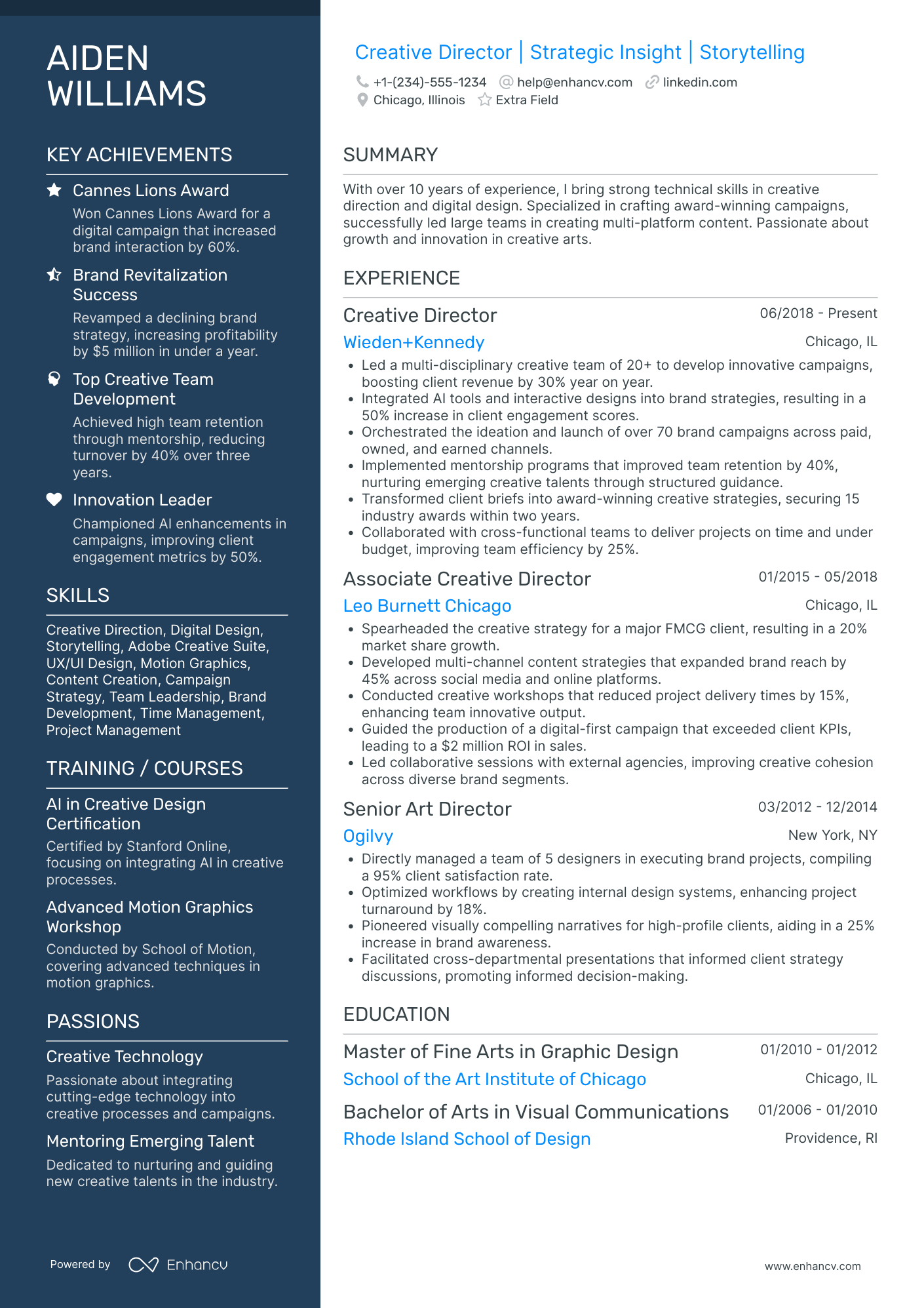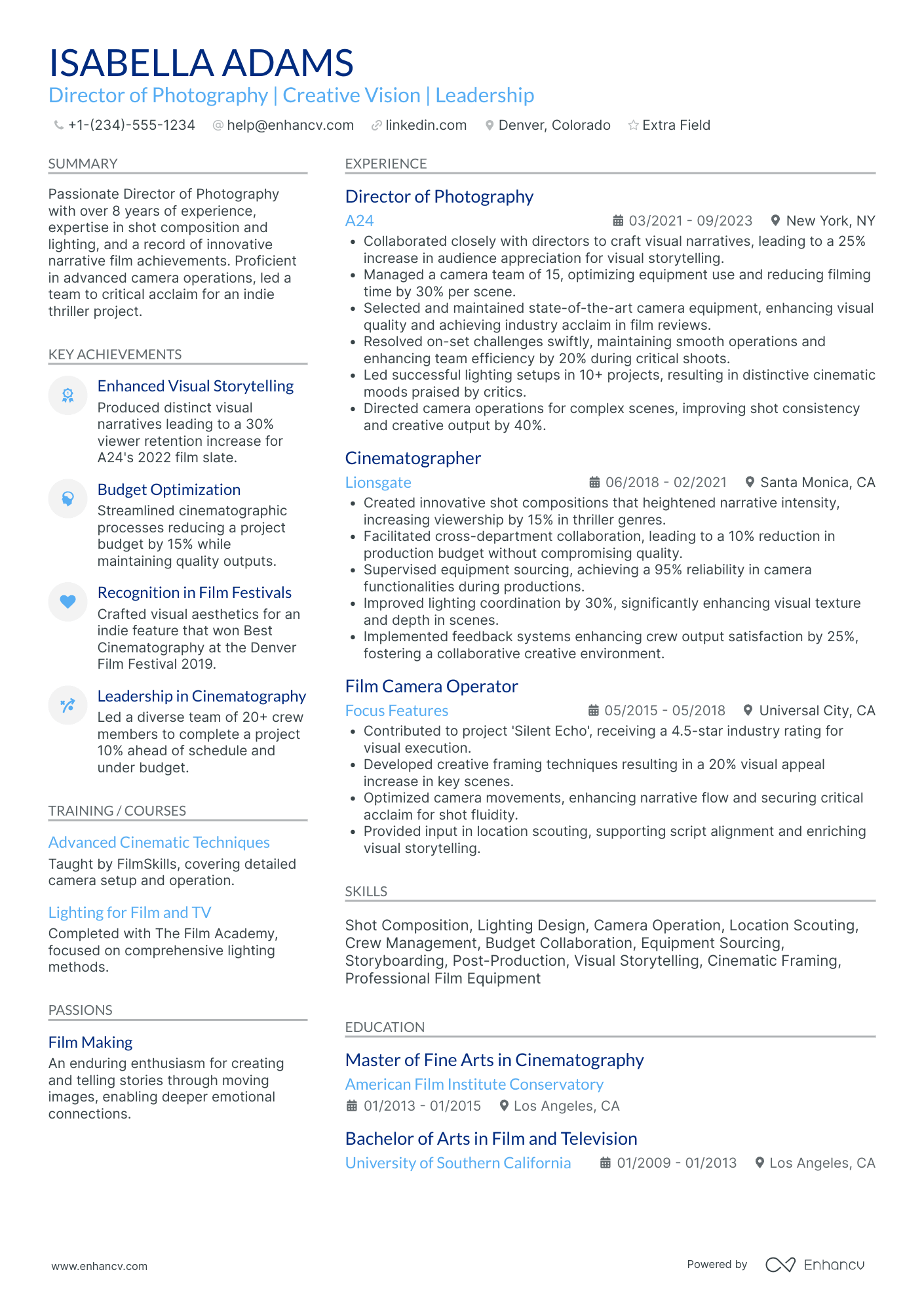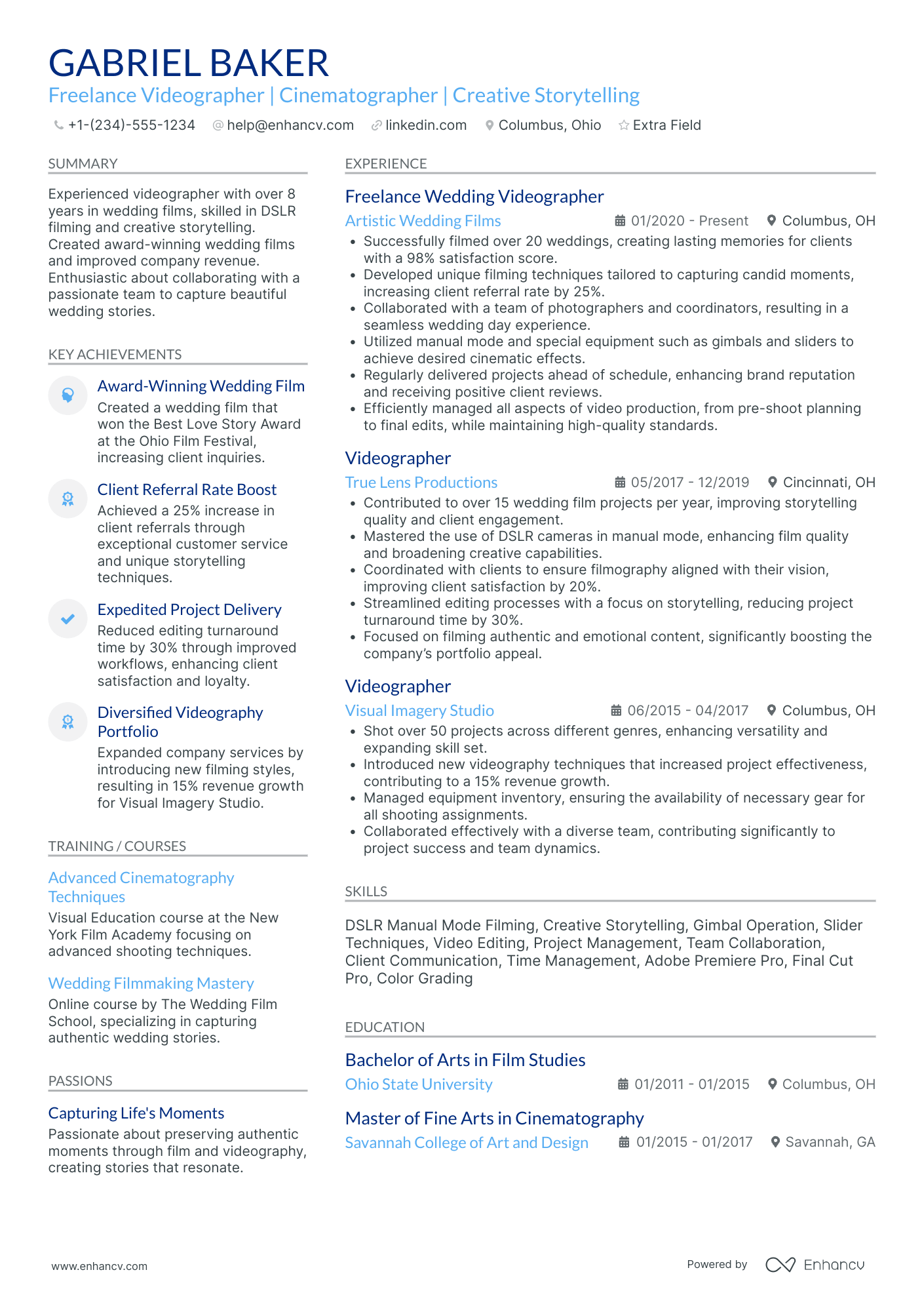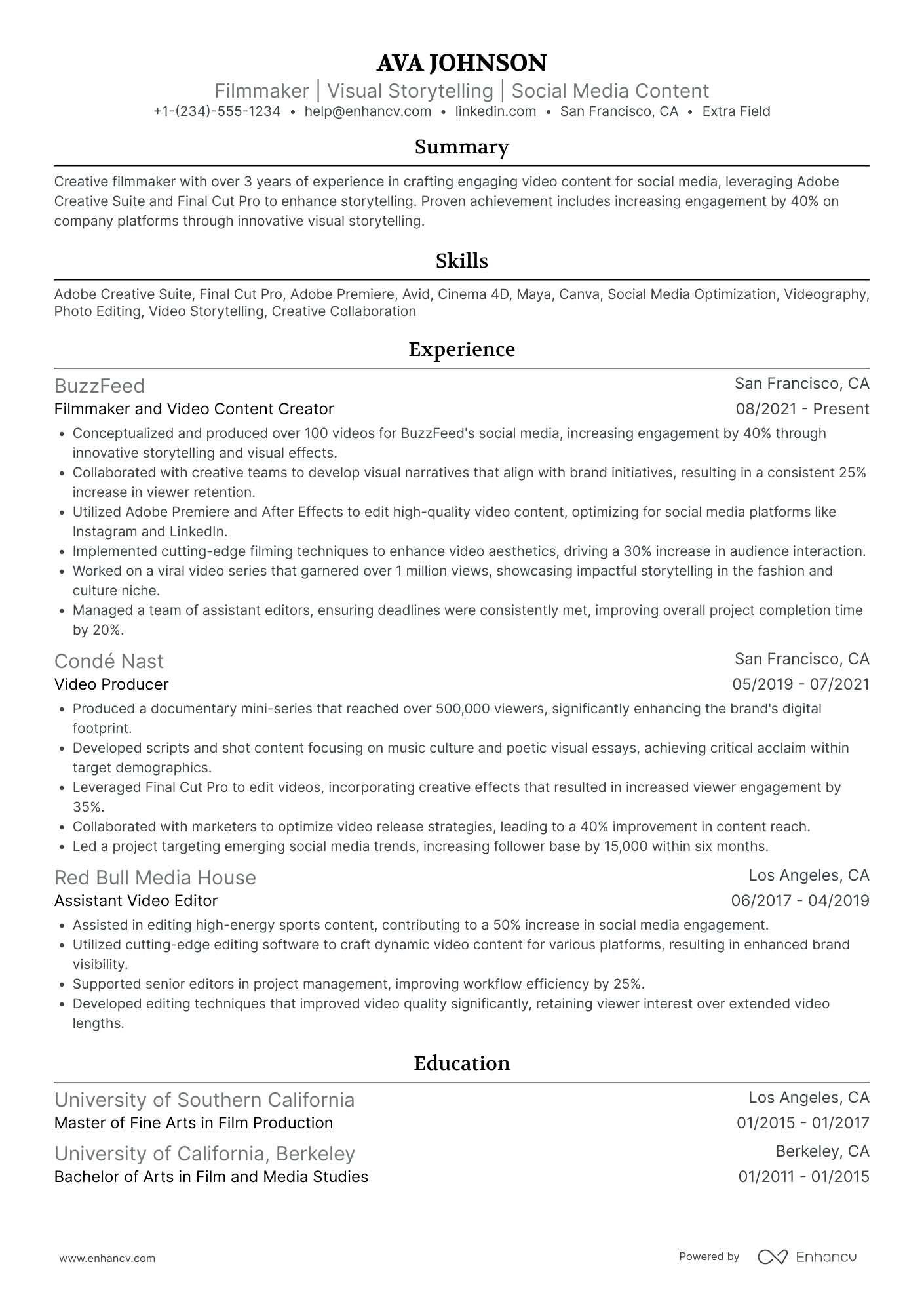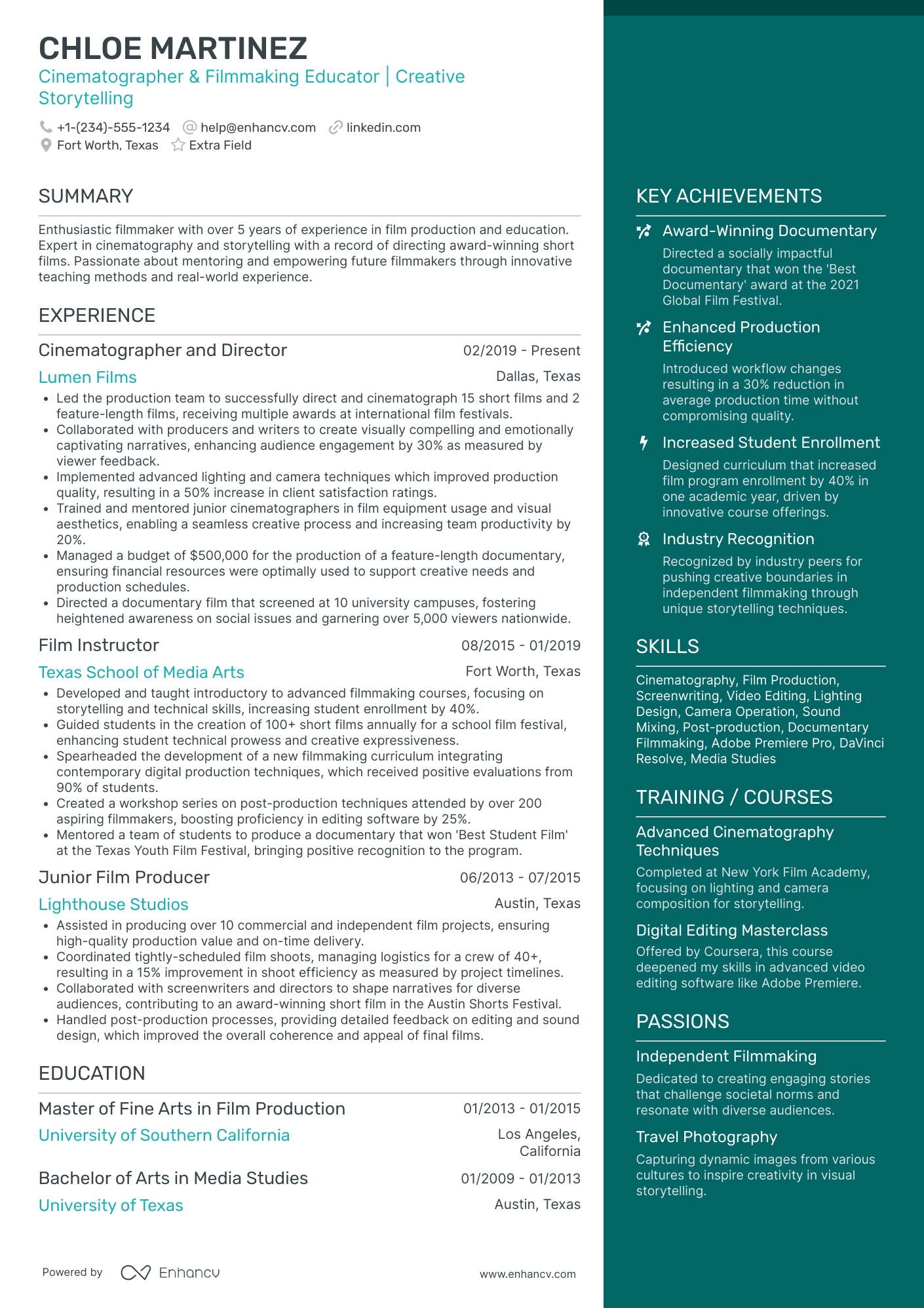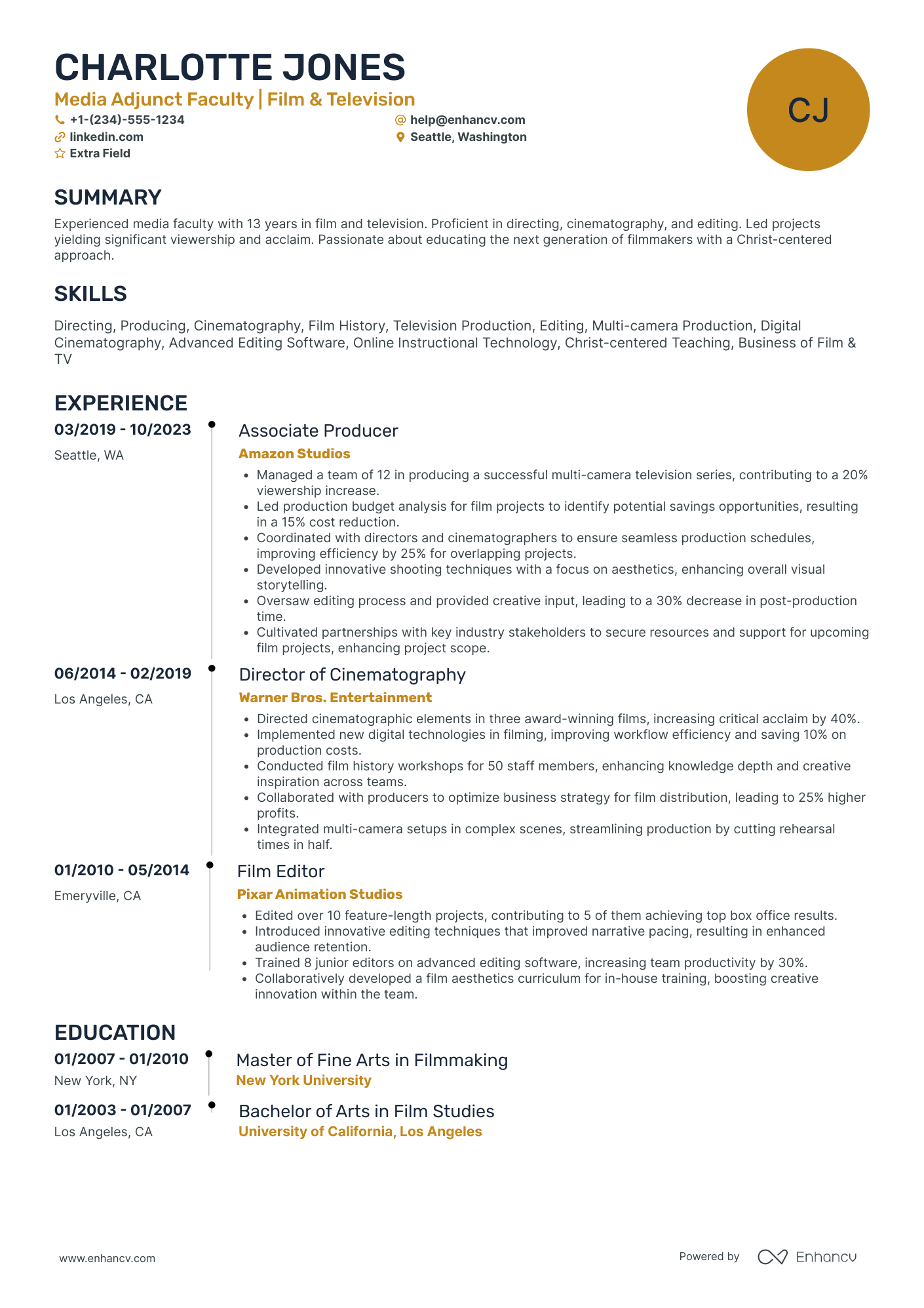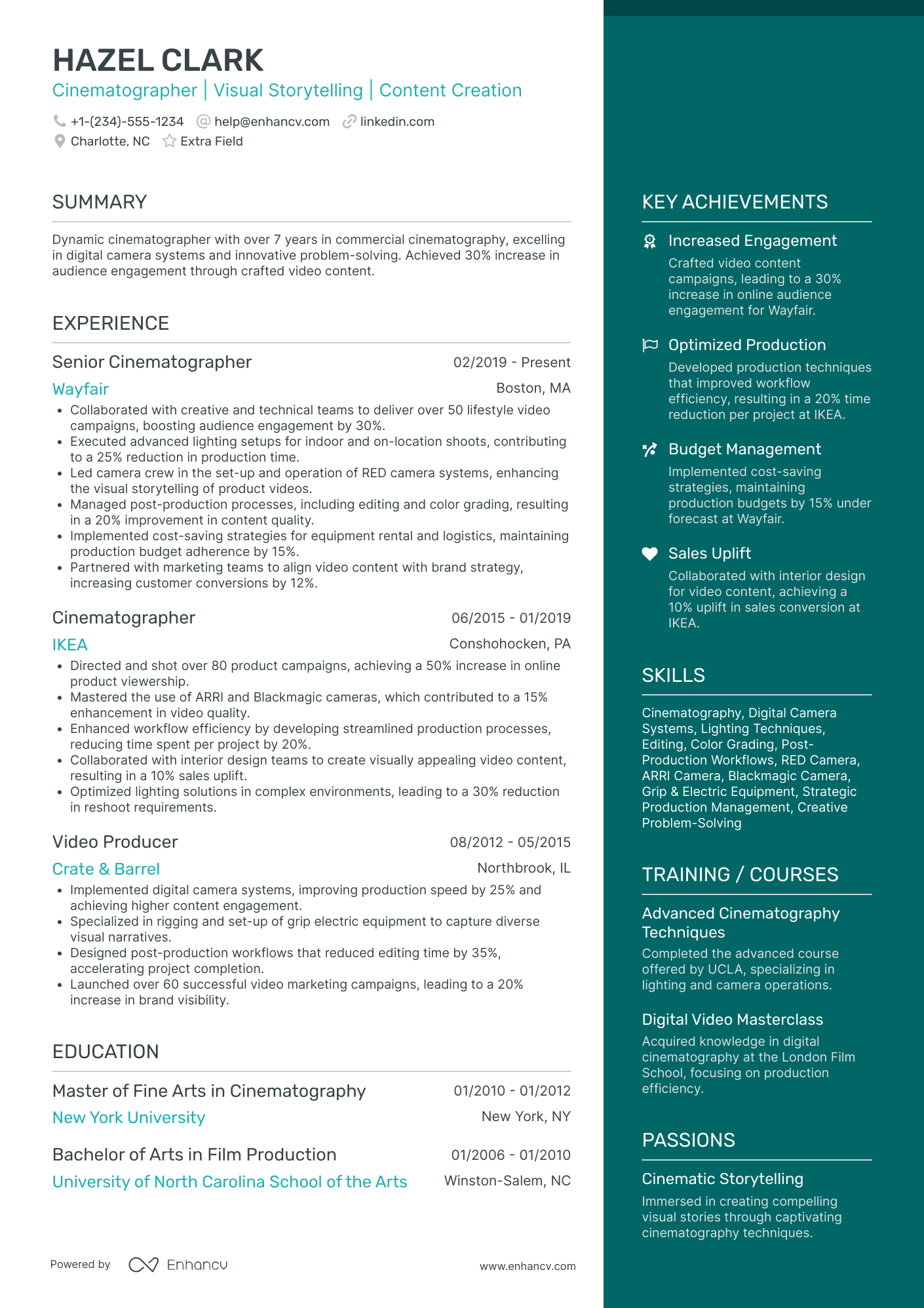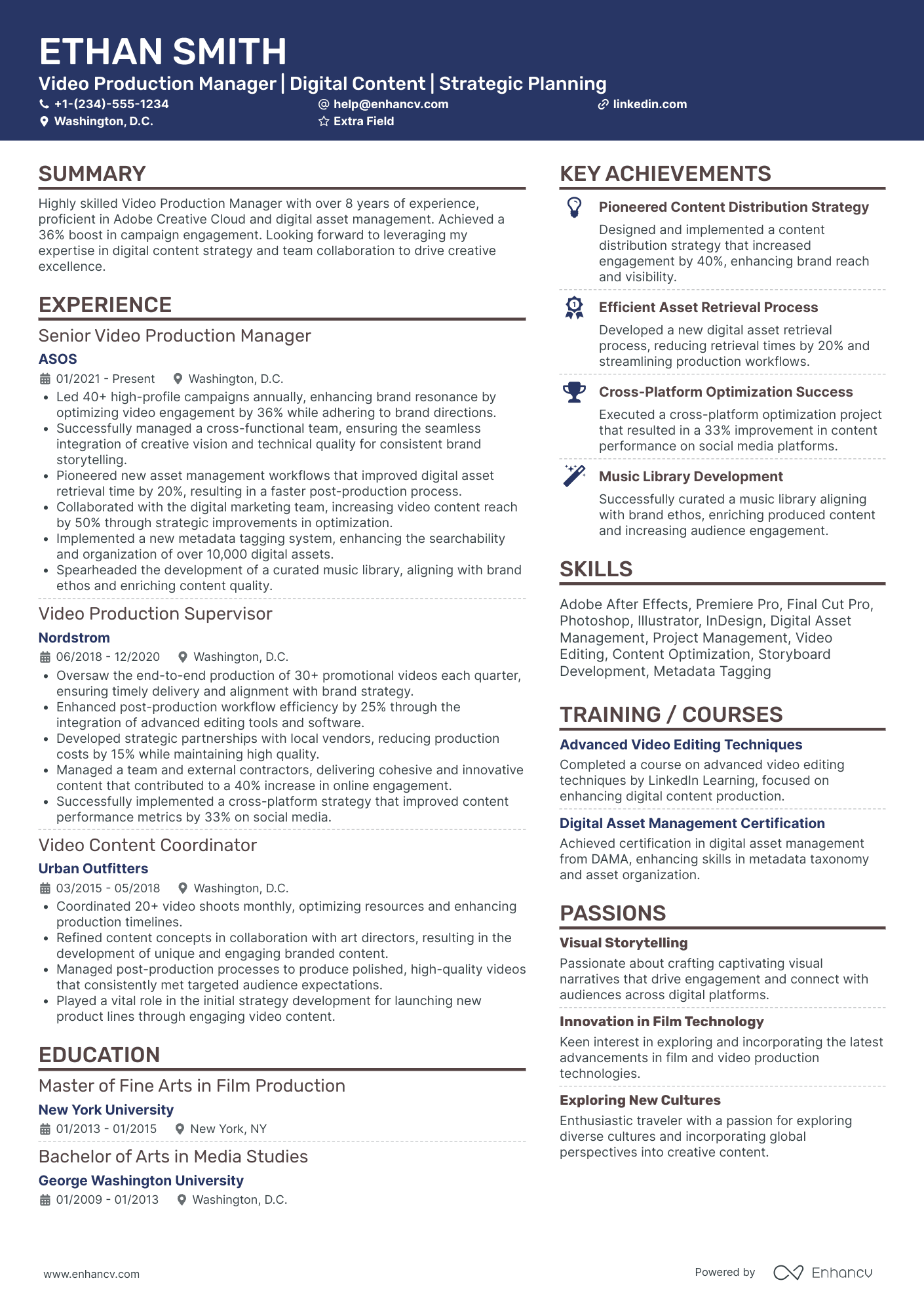As a cinematographer, crafting a resume that effectively showcases your distinct visual style and project diversity can be daunting. Our guide provides clear strategies to demonstrate your unique talents, ensuring your resume captivates potential employers with a compelling narrative of your creative journey.
- Utilize real-life examples to refine your cinematographer resume;
- Effectively write the experience section of your cinematographer resume, even if you have minimal or no professional experience;
- Incorporate the industry's top 10 essential skills throughout your resume;
- Include your education and certifications to highlight your specific expertise.
If the cinematographer resume isn't the right one for you, take a look at other related guides we have:
Cinematographer Resume Format Made Simple
You don't need to go over the top when it comes to creativity in your cinematographer resume format .
What recruiters care about more is the legibility of your cinematographer resume, alongside the relevancy of your application to the role.
That's why we're presenting you with four simple steps that could help your professional presentation check all the right boxes:
- The reverse-chronological resume format is the one for you, if you happen to have plenty of relevant (and recent) professional experience you'd like to showcase. This format follows a pretty succinct logic and puts the focus on your experience.
- Keep your header simple with your contact details; a headline that details the role you're applying for or your current job; and a link to your portfolio.
- Ensure your resume reaches an up-to-two-page limit, only if you happen to be applying for a more senior role or you have over a decade of relevant experience.
- Save your cinematographer resume as a PDF to retain its structure and presentation.
The layout of a resume can differ by region – Canadian resumes may use a distinct format.
Upload & Check Your Resume
Drop your resume here or choose a file. PDF & DOCX only. Max 2MB file size.
PRO TIP
If you happen to have some basic certificates, don't invest too much of your cinematographer resume real estate in them. Instead, list them within the skills section or as part of your relevant experience. This way you'd ensure you meet all job requirements while dedicating your certificates to only the most in-demand certification across the industry.
Fundamental sections for your cinematographer resume:
- The header with your name (if your degree or certification is impressive, you can add the title as a follow up to your name), contact details, portfolio link, and headline
- The summary or objective aligning your career and resume achievements with the role
- The experience section to curate neatly organized bullets with your tangible at-work-success
- Skills listed through various sections of your resume and within an exclusive sidebar
- The education and certifications for more credibility and industry-wide expertise
What recruiters want to see on your resume:
- Extensive knowledge of camera equipment, lenses, lighting techniques, and filming styles.
- Experience in different genres and formats (feature films, television, commercials, documentaries).
- Demonstrable visual storytelling ability and artistic vision, as evidenced by a strong reel or portfolio.
- Technical proficiency in industry-standard software (e.g., Adobe Creative Suite, DaVinci Resolve) and camera hardware (e.g., ARRI, RED, Sony).
- Collaborative experience with directors, production crews, and post-production teams to achieve desired aesthetic outcomes.
Adding Your Relevant Experience to Your Cinematographer Resume
If you're looking for a way to show recruiters that your expertise is credible, look no further than the resume experience section.
Your cinematographer resume experience can be best curated in a structured, bulleted list detailing the particulars of your career:
- Always integrate metrics of success - what did you actually achieve in the role?
- Scan the cinematographer advert for your dream role in search of keywords in the job requirements - feature those all through your past/current experience;
- Dedicate a bullet (or two) to spotlight your technical capabilities and how you're able to use the particular software/technology in your day-to-day roles;
- Write simple by including your responsibility, a job advert keyword or skill, and a tangible outcome of your success;
- Use the experience section to also define the unique value of working with you in the form of soft skills, relevant feedback, and the company culture you best thrive in.
Industry leaders always ensure that their resume experience section offers an enticing glimpse at their expertise, while telling a career narrative. Explore these sample cinematographer resumes on how to best create your resume experience section.
- Operated advanced camera rigs and drones, capturing over 500 hours of raw footage for 'Epic Journeys', which helped secure the film's nomination for Best Cinematography at the Sundance Film Festival.
- Collaborated closely with the director to develop and execute a visual style that increased the movie's distribution reach, leading to screens in 40+ countries worldwide.
- Utilized naturally lit environments to reduce artificial lighting needs by 30%, significantly lowering production costs while maintaining aesthetic integrity.
- Led a camera crew of 10 to produce high-end commercial content for clients like Nike, resulting in a 20% increase in client satisfaction ratings.
- Implemented new post-production workflows with the latest software, reducing editing time by 25% without compromising on the visual quality of the final product.
- Directed the photography for a series of successful crowdfunding campaign videos that raised over $1M in funding for various startups.
- Crafted unique visual narratives for over 15 short films, one of which, 'Forgotten Dreams', won the Audience Choice Award at the Toronto Short Film Festival.
- Managed a tight budget effectively by employing guerrilla filmmaking techniques that maximized on-location shooting, reducing set design expenses by 40%.
- Pioneered the use of mobile camera technology to create dynamic action sequences in indie film productions, enhancing the audience's immersive experience.
- Developed a distinctive visual style for the hit TV series 'City of Shadows', which contributed to its critical acclaim and average viewership of 5 million per episode.
- Orchestrated complex multi-camera setups for live events, balancing various elements to maintain continuity and enhance the storytelling aspect of live broadcasts.
- Piloted the transition to 4K HDR filming for the series, providing viewers with a superior visual quality that set a new standard for television cinematography.
- Spearheaded the cinematographic direction for the critically acclaimed documentary 'The Unseen World', which has been featured in over 30 international film festivals.
- Employed drone cinematography to capture breathtaking aerial shots that helped illustrate the scale of environmental issues presented in the documentary.
- Trained a team of junior cinematographers, enhancing the overall skill set of the production crew and allowing for a 50% increase in production output.
- Designed and executed a digital content strategy that generated an average of 1 million views per video project for top-tier clients like Red Bull.
- Streamlined digital workflow by integrating cloud-based collaboration, allowing team members to work remotely which resulted in a 20% production speed increase.
- Managed the creation of virtual reality content, positioning the production studio as an early adopter in the field and securing a 15% growth in market share.
- Specialized in extreme sports cinematography, capturing stunning footage that led to viral marketing campaigns with over 100 million online views.
- Developed effective stabilizing techniques for action shots that resulted in crisp, clear images, even under the most strenuous filming conditions.
- Forged strong partnerships with action sports brands, contributing to a 30% increase in demand for action-centric cinematographic services.
- Led the evolution of the studio's visual language by integrating mixed media elements, which broadened narrative possibilities and attracted a 25% larger audience demographic.
- Cultivated a diverse network of creative professionals, facilitating resource sharing that led to a 40% reduction in production times for collaborative projects.
- Proactively sought out new technologies and successfully incorporated virtual production methods that reduced location shooting costs by 35%, without losing authenticity in storytelling.
The following content includes information from "O*NET OnLine" by the U.S. Department of Labor, Employment and Training Administration (USDOL/ETA). Used under the CC BY 4.0 license. The data represents the top responsibilities present on the task lists for cinematographer professionals.
Top Responsibilities for Cinematographer:
- Compose and frame each shot, applying the technical aspects of light, lenses, film, filters, and camera settings to achieve the effects sought by directors.
- Operate television or motion picture cameras to record scenes for television broadcasts, advertising, or motion pictures.
- Adjust positions and controls of cameras, printers, and related equipment to change focus, exposure, and lighting.
- Confer with directors, sound and lighting technicians, electricians, and other crew members to discuss assignments and determine filming sequences, desired effects, camera movements, and lighting requirements.
- Operate zoom lenses, changing images according to specifications and rehearsal instructions.
- Observe sets or locations for potential problems and to determine filming and lighting requirements.
- Set up and perform live shots for broadcast.
- Use cameras in any of several different camera mounts, such as stationary, track-mounted, or crane-mounted.
- Test, clean, maintain, and repair broadcast equipment, including testing microphones, to ensure proper working condition.
- Edit video for broadcast productions, including non-linear editing.
Quantifying impact on your resume
- Include the total number of film projects you've worked on to demonstrate your experience.
- List the budgets of films you've worked on to show your familiarity with financial constraints.
- Mention the number of awards or nominations received for your work to highlight excellence in your field.
- Specify the number of team members you've managed to display leadership and collaboration skills.
- Count the different types of cameras and equipment you are proficient with to showcase versatility and technical knowledge.
- State the total hours of footage you've shot to illustrate your dedication and work ethic.
- Quantify the number of different shooting locations to indicate adaptability and logistical planning ability.
- Detail the viewership numbers or box office revenue of your most popular works to underline the commercial success of your projects.
Action verbs for your cinematographer resume
What if you don't have any experience?
There are two very common scenarios about candidates with less experience. They are either:
- Fresh out of college in search of a cinematographer role
- Transferring over from a completely different field
Both of these types of candidates still have a shot at landing their first job in the industry.
All they need to do about the experience section of their cinematographer resume is:
- Consider their strengths - would the outcomes of their previous roles or niche skill sets impress recruiters? Feature those towards the top of your resume
- Exclude any and all irrelevant experience items - remember that at the end of the day, you're telling a story that aims to align with the ideal candidate for the cinematographer job
- Win recruiters over with personality - perhaps your ambition, dreams, and diligence would make you the perfect fit for the cinematographer role. Dedicate resume space to detail your personality traits by showcasing how they've helped you succeed in past roles
- Tailor your experience to specific job requirements - ensure your cinematographer resume answers the advert in the best way possible.
Recommended reads:
PRO TIP
Highlight any significant extracurricular activities that demonstrate valuable skills or leadership.
How to Showcase Hard Skills and Soft Skills on Your Resume
Reading between the lines of your dream job, you find recruiters are looking for candidates who have specific software or hardware knowledge, and personal skills.
Any technology you're adept at shows your hard skills. This particular skill set answers initial job requirements, hinting at how much time your potential employers would have to invest in training you. Showcase you have the relevant technical background in your communicate, solve problems, and adapt to new environments. Basically, your interpersonal communication skills that show recruiters if you'd fit into the team and company culture. You could use the achievements section to tie in your greatest wins with relevant soft skills.
It's also a good idea to add some of your hard and soft skills across different resume sections (e.g. summary/objective, experience, etc.) to match the job requirements and pass the initial screening process. Remember to always check your skill spelling and ensure that you've copy-pasted the name of the desired skills from the job advert as is.
Top skills for your cinematographer resume:
Camera Operation
Lighting Techniques
Color Grading
Lens Selection
Dolly and Crane Operation
Video Editing Software (e.g., Adobe Premiere, Final Cut Pro)
Camera Stabilization Equipment (e.g., gimbals, steadicams)
Drone Operation
Digital Cinematography
Sound Recording Techniques
Creativity
Collaboration
Attention to Detail
Problem Solving
Communication
Time Management
Adaptability
Critical Thinking
Leadership
Emotional Intelligence
Next, you will find information on the top technologies for cinematographer professonals from "O*NET OnLine" by the U.S. Department of Labor, Employment and Training Administration (USDOL/ETA). Used under the CC BY 4.0 license.
Top technologies for Cinematographer’s resume:
- Adobe After Effects
- YouTube
- Adobe Creative Cloud software
- Adobe Illustrator
- Litchi
- Pix4D Pix4Dcapture
PRO TIP
If you happen to have plenty of certificates, select the ones that are most applicable and sought-after across the industry. Organize them by relevance to the role you're applying for.
Certifications and Education: In-demand Sections for Your Cinematographer Resume
Your academic background in the form of certifications on your resume and your higher degree education is important to your application.
The certifications and education sections pinpoint a variety of hard and soft skills you possess, as well as your dedication to the industry.
Add relevant certificates to your cinematographer resume by:
- Add special achievements or recognitions you've received during your education or certification, only if they're really noteworthy and/or applicable to the role
- Be concise - don't list every and any certificate you've obtained through your career, but instead, select the ones that would be most impressive to the role
- Include the name of the certificate or degree, institution, graduation dates, and certificate license numbers (if possible)
- Organize your education in reverse chronological format, starting with the latest degree you have that's most applicable for the role
Think of the education and certification sections as the further credibility your cinematographer resume needs to pinpoint your success.
Now, if you're stuck on these resume sections, we've curated a list of the most popular technical certificates across the industry.
Have a look, below:
The top 5 certifications for your cinematographer resume:
- Cinematography Certificate (CC) - New York Film Academy
- Digital Cinematography Certificate (DCC) - Boston University
- Graduate Certificate in Cinematography (GCC) - American Film Institute
- Professional Program in Producing (PPP) - University of California, Los Angeles
- Master of Fine Arts in Cinematography (MFA) - American Film Institute
The content below includes information from "O*NET OnLine" by the U.S. Department of Labor, Employment and Training Administration (USDOL/ETA). Used under the CC BY 4.0 license. The data represents the top associations for cinematographer professionals.
Top US associations for a Cinematographer professional
- American Guild of Court Videographers
- Association for Uncrewed Vehicle Systems International
- Drone Safety Team
- International Alliance of Theatrical Stage Employees, Moving Picture Technicians, Artists and Allied Crafts
- International Brotherhood of Electrical Workers
PRO TIP
If you failed to obtain one of the certificates, as listed in the requirements, but decide to include it on your resume, make sure to include a note somewhere that you have the "relevant training, but are planning to re-take the exams". Support this statement with the actual date you're planning to be re-examined. Always be honest on your resume.
Recommended reads:
The Summary Or Objective: Focusing on the Top One-third of Your Resume
It's a well-known fact that the top one-third of your cinematographer resume is the make-it-or-break-it moment of your application. The resume summary and objective could help you further build up your professional profile.
- If you have plenty of career highlights behind your back, use the resume summary . The cinematographer summary immediately focuses recruiters' attention on what matters most within your experience.
- The resume objective is the perfect choice for balancing your career achievements with your vision. Use it to state precisely how you see yourself in a couple of years' time - as part of the company you're applying for.
Both the resume summary and resume objective can be your value pitch to potential employers: answering what makes your application unique and the top choice for the cinematographer role. They both have to be specific and tailored - as there's no one-size-fits-all approach to writing your cinematographer summary or objective. Use the cinematographer examples below as a starting point:
Resume summaries for a cinematographer job
- With over 8 years of professional experience sculpting visuals for feature films, I have mastered technical proficiencies in camera operation, lighting, and composition. My work on the acclaimed documentary 'Echoes of the Valley' earned a Best Cinematography award, showcasing my ability to create compelling narratives through images.
- Award-winning photographer aspiring to transition to the world of motion pictures, I bring a unique visual style honed over a decade of experience capturing stills. My profound knowledge of lighting techniques and composition will enrich any project, keen to leverage my artistic background in a cinematic context.
- Seasoned graphic designer with a passion for film seeks to pivot talents to cinematography. With 5 years of experience in the creation of visually arresting designs and an acute eye for detail, I possess a strong foundation in the principles of visual storytelling and the technical aptitude to adapt quickly to cinematographic equipment and software.
- Offering a robust combination of 10 years in video production and a lifelong passion for filmmaking, I have developed a deep understanding of visual storytelling that translates to impactful and emotive cinematography. My direction of photography on the short film 'Waves' received critical acclaim and opened avenues for innovative visual experimentation.
- As a recent film school graduate, I am eager to contribute a fresh perspective and contemporary techniques learned from industry professionals. My keen eye for detail and dedication to crafting visually stunning content align perfectly with the cutting-edge projects of a vibrant production team.
- Driven by a lifelong fascination with cinema, I am committed to beginning a career in cinematography, seeking opportunities to apply my theoretical knowledge gained from extensive coursework in film theory and composition. My objective is to learn hands-on and contribute creatively to meaningful and engaging film projects.
Optimize your resume summary and objective for ATS
Drop your resume here or choose a file.
PDF & DOCX only. Max 2MB file size.
Average Salary Info by State in the US for Cinematographer Professionals
Local salary info for Cinematographer.” Source: My Next Move, National Center for O*NET Development. Accessed 10/15/2024
| State | Average Salary (in USD) |
|---|---|
| US National Average | $61,800 |
| California (CA) | $67,950 |
| Texas (TX) | $62,700 |
| Florida (FL) | $50,600 |
| New York (NY) | $93,880 |
| Pennsylvania (PA) | $49,350 |
| Illinois (IL) | $38,170 |
| Ohio (OH) | $48,840 |
| Georgia (GA) | $59,140 |
| North Carolina (NC) | $62,420 |
| Michigan (MI) | $51,450 |
Other Relevant Sections for Your Cinematographer Resume
Apart from the standard cinematographer resume sections listed in this guide, you have the opportunity to get creative with building your profile. Select additional resume sections that you deem align with the role, department, or company culture. Good choices for your cinematographer resume include:
- Language skills - always ensure that you have qualified each language you speak according to relevant frameworks;
- Hobbies - you could share more about your favorite books, how you spend your time, etc. ;
- Volunteering - to highlight the causes you care about;
- Awards - for your most prominent cinematographer professional accolades and achievements.
Make sure that these sections don't take too much away from your experience, but instead build up your cinematographer professional profile.
Key Takeaways
- Ensure your cinematographer resume uses a simple, easy-to-read format that reflects upon your experience and aligns with the role;
- Be specific within the top one-third of your resume (header and summary or objective) to pinpoint what makes you the ideal candidate for the cinematographer role;
- Curate information that is tailored to the job by detailing skills, achievements, and actual outcomes of your efforts;
- List your certifications and technical capabilities to demonstrate your aptitude with specific software and technologies;
- The sections you decide on including on your cinematographer should pinpoint your professional expertise and personality.
Cinematographer resume examples
By Experience
Senior Cinematographer
Lead Cinematographer
Junior Cinematographer
Cinematographer Intern
By Role
